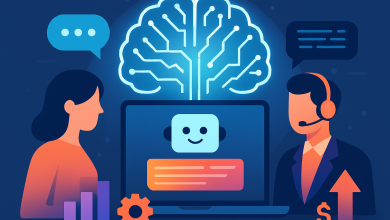
Enterprises everywhere are racing to adopt AI in their products and customer experiences. Far fewer are examining how AI is transforming their own workforce and operating model– and whether their current structures can keep pace.
Too often, the approach to “AI workforce transformation” starts and ends at reskilling or layering new AI tools into existing workflows, such as customer support automation or predictive analytics. But AI isn’t just enhancing individual tasks –it’s fundamentally reshaping how work happens across the entire organization: how tasks are distributed, how teams operate, and how talent is deployed.
Traditional models– static org charts, fixed job descriptions, annual workforce plans– can’t capture the new reality of dynamic AI-enabled work. If leaders don’t rethink the architecture of work itself, they’ll find their organizations lagging behind more agile competitors who are actively redesigning their organizations for an AI-driven future
AI Is Driving Work to the Task Level
In an AI-driven organization, work no longer fits neatly into static job descriptions. Instead, AI is accelerating a shift toward task-level transformation. In an AI-driven organization, work is no longer defined by rigid roles but by fluid tasks that can be reassigned, reimagined, or automated. This shift from role-based to task-based work requires a fundamental rethinking of how organizations design jobs, deploy talent, and develop skills.
Certain tasks that once required human effort are now automated, augmented, or redefined through AI. In many cases, this reshapes not just the speed or efficiency of work, but its very nature. For example:
- A compliance analyst who once reviewed reports line by line is now overseeing AI-generated summaries and investigating anomalies.
- A product manager isn’t just documenting user requirements: they’re collaborating with AI tools to prototype new features.
As this shift deepens, traditional roles fragment. Roles have always involved a mix of tasks, but that mix is now changing faster than ever, making static job descriptions and workforce plans increasingly outdated.
This has profound implications for talent strategy. Leaders can no longer think in terms of static roles to be filled. They must focus on:
- What tasks drive business outcomes
- How those tasks are evolving with AI
- What skills and capabilities are needed to deliver them, now and in the future
Organizations that proactively map how AI is transforming work, and realign their workforce strategy to match, won’t just keep pace; they’ll set the standard for agility, innovation, and sustained performance in an AI-driven economy.
Why Org Charts No Longer Map to How Work Gets Done
AI is also disrupting how work flows across the organization. The traditional hierarchical org chart –designed for stability and clear reporting lines– is increasingly out of sync with the way AI-enabled companies operate.
AI powers real-time, cross-functional workflows that respond to changing data and business needs. Instead of tasks flowing linearly through departments, AI systems can automatically route work to the right people or systems based on skills, availability, or emerging priorities. For example, AI might detect a sudden market shift, trigger changes in a campaign strategy, and reassign work to the team best equipped to respond, all without waiting for formal managerial direction.
As a result, teams are being assembled and reassembled around capabilities and outcomes, not job titles or org charts. Workflows flex continuously as AI surfaces new insights, automates steps, or redistributes responsibilities, blurring the lines between roles and accelerating execution across the business.
In this environment, static headcount planning quickly becomes obsolete. Leaders must shift to a more dynamic, skills-based view of their workforce:
- What skills and expertise exist across the organization, even if not visible in current job titles
- How can those capabilities be deployed flexibly across projects and teams
- Where gaps are emerging as AI reshapes work
AI itself can be a powerful enabler here. By analyzing talent data and surfacing hidden skills and potential, AI can help leaders move from rigid role-based planning to a more agile, capability-driven model.
The result is a workforce architecture that is more resilient, adaptive, and aligned to real-time business needs: essential traits in an era of continuous transformation.
Building the Skills to Collaborate with AI
As AI becomes embedded in day-to-day work, organizations need to ensure employees are equipped with the skills and capabilities to adapt.
This goes beyond learning new tools. It’s about understanding how to collaborate with AI systems, knowing their strengths and limitations, applying them effectively in context, and maintaining accountability for outcomes.
Developing this type of AI fluency, the ability to work effectively alongside AI, make informed decisions about its use, and manage its impacts, is becoming essential across all functions.
In product teams, this might mean leveraging AI to accelerate development or personalize user experiences. In marketing and sales, it could involve using AI-driven insights and content generation, while ensuring human oversight and quality remain central. For leaders, it requires making strategic decisions about where and how to apply AI, and how to manage emerging risks and ethical considerations.
As the nature of work continues to evolve, organizations that prioritize building these AI-related capabilities across their workforce will be better positioned to drive value and to adapt as AI technologies continue to advance.
Redesigning Workforce Strategy for an AI-Transformed Organization
AI is evolving too rapidly for traditional workforce planning cycles to keep up. Static headcount targets, annual talent plans, and siloed systems can’t support the speed or complexity of today’s work.
To stay competitive, organizations need a new strategy: one that reflects how AI is reshaping both the nature of work and the structure of the workforce.
That starts with moving from rigid, role-based planning to a skills-based approach. CHROs need real-time visibility into what work is getting done, how tasks are shifting, and where critical capabilities exist across the organization.
But smarter planning alone isn’t enough. Companies also need to rethink how work gets done day-to-day, building flexible operating models that can adapt as AI transforms workflows in real-time.
That includes:
- Designing teams and structures around dynamic skills and capabilities
- Enabling people to move fluidly across roles and projects
- Embedding AI fluency across functions to ensure employees can collaborate effectively with new tools
- Using AI to surface hidden talent and allocate work more intelligently
Organizations that take this approach, combining data-driven planning with flexible execution, will be better positioned to adapt, innovate, and lead in the next era of work.





